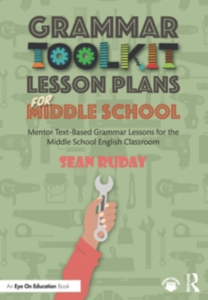By Sean Ruday
 When I was in middle school, I loved playing running back in playground football games. An avid football fan, I examined the tactics of the great NFL running backs I saw on television and then tried to use those same strategies when playing football with my classmates at recess.
When I was in middle school, I loved playing running back in playground football games. An avid football fan, I examined the tactics of the great NFL running backs I saw on television and then tried to use those same strategies when playing football with my classmates at recess.
For example, after I watched Detroit Lions’ running back Barry Sanders spin past defenders, I worked to implement his incredible spin move in my own games. At the time, I had no idea I was using a learning approach that I would be drawing on over 30 years later as a professor and professional developer who focuses on grammar instruction!
Taking a Mentor Text-Based Approach to Grammar Instruction
Now that I teach, write, and lead professional development workshops about grammar instruction, I do fewer spin moves, but I still have a similar conceptual approach to my work. When I share insights on teaching grammar, I emphasize the importance of mentor texts, published examples that contain strategies and concepts from which students can learn.
 For example, when working with middle school students on the grammatical concept of prepositional phrases, I showed them an excerpt from the book Amal Unbound by Aisha Saeed that uses prepositional phrases to help readers visualize what is taking place in the story and understand the details of the narration.
For example, when working with middle school students on the grammatical concept of prepositional phrases, I showed them an excerpt from the book Amal Unbound by Aisha Saeed that uses prepositional phrases to help readers visualize what is taking place in the story and understand the details of the narration.
The students and I discussed what prepositional phrases are, identified examples in the passage, and reflected on the importance of those prepositional phrase examples to the effectiveness of the piece.
After that conversation, students worked on using prepositional phrases in their own writing, incorporating this grammatical concept when relevant to add details to their work.
Finally, students reflected on their work, identifying prepositional phrases they used and writing responses to the following questions:
1) Why are the prepositional phrases you used important to the piece you wrote?
2) How would your piece be different if you did not use those prepositional phrases?
Just as I learned about the importance of spin moves for an elusive football running back and how to implement them by watching Barry Sanders play football, I try to help students develop deep and meaningful understandings about the importance of grammatical concepts by examining how published authors use those concepts.
While the example above focuses on prepositional phrases, this same approach can be applied to any aspect of grammar. By examining how favorite published authors use grammatical concepts, considering the importance of those concepts, using them in their own writing, and reflecting on the concepts’ impacts, students will work with grammar in meaningful and thoughtful ways.
Key Benefits of Mentor Text-Based Grammar Instruction
There are four key benefits that I associated with mentor text-based grammar instruction: engagement, ownership, connection, and empowerment. Here is how each benefit relates to mentor text-based grammar instruction.
Benefit One: Engagement
One benefit I have seen in mentor text-based grammar instruction is enhanced student engagement. This approach creates a dynamic learning experience in which students can read texts that interest them, reflect on the grammatical features that make those texts strong, and actively apply those features to their writing.
As teachers, we can identify mentor examples of high-interest texts and create opportunities for students to apply key grammatical concepts to writings about topics that interest them, maximizing their potential engagement.
Benefit Two: Ownership
Mentor text-based grammar instruction can also facilitate students’ feelings of ownership and deepen understandings of the grammatical concepts they’re studying. When students think deeply about how and why a grammatical concept is used in a published text and then implement it in their writing, they can develop a sense of ownership and awareness of that concept.
Students can see the concepts as tools they possess and are then able to intentionally use them in their works. They see them as strategies to make their works better, and not just out-of-context rules they are told to memorize without deeper application or meaning.

Benefit Three: Connection
I also love the way that mentor text-based grammar instruction can help students see authentic connections between their writing and the works of published authors they admire. When I share published examples of grammatical concepts with students, I emphasize that the students not only will looking be at how published authors use grammatical concepts, but also will be implementing these same tools in their own writing and comparing their usage of the concept with how the writer uses it.
Benefit Four: Empowerment
I have seen the combination of these benefits – engagement, ownership, and connection – lead to a sense of student empowerment in grammar instruction. These experiences energize students with a sense of purpose. Instead of seeing grammar instruction as focused on worksheets, memorization, and out-of-context exercises that have no connection to real-world writing and usage, students reconceptualize grammatical concepts as important tools for communication and conclude that they – like their favorite authors – can use grammar meaningfully. This empowerment experience will benefit our students in all of the writing they do – in the present and in the future.
Final Thoughts on Mentor Text-Based Grammar Instruction
When I imitated Barry Sanders’ spin moves in playground football games, I had the same type of engaging, ownership-oriented, connecting, and empowering experience that mentor text-based grammar instruction can facilitate for our student writers. Through this process, we can help our students see grammatical concepts as tools for meaningful and effective writing that they can use for the rest of their lives.
 Sean Ruday (he/him/his) is a professor and program coordinator of English education at Longwood University. He has taught English and language arts in New York, Massachusetts, and Virginia. Sean is the founding editor of the Journal of Literacy Innovation. He has written 18 books on literacy instruction, all published by Routledge/Eye On Education, including the forthcoming Grammar Toolkit Lesson Plans for Middle School: Mentor Text-Based Grammar Lessons for the Middle School English Classroom.
Sean Ruday (he/him/his) is a professor and program coordinator of English education at Longwood University. He has taught English and language arts in New York, Massachusetts, and Virginia. Sean is the founding editor of the Journal of Literacy Innovation. He has written 18 books on literacy instruction, all published by Routledge/Eye On Education, including the forthcoming Grammar Toolkit Lesson Plans for Middle School: Mentor Text-Based Grammar Lessons for the Middle School English Classroom.
Feature image: classroom library, It’s Lit Teaching.


